
|
GREATEST FILM SCENES The Silents (1) |
|
|
|
# 1. The Birth of a Nation (1915) A controversial, reprehensible, explicitly racist, but ground-breaking, landmark American epic film masterpiece - these all describe producer/director D. W. Griffith's cinematic work. In particular, it is remarkable for its cinematic feel and spectacle of splendidly-staged Civil War battle scenes with historical costuming and hundreds of extras. On the battlefield, eldest son Benjamin Cameron (Henry B. Wathall), known as "the Little Colonel" leads a final desperate assault against the Union command of Capt. Phil Stoneman (Elmer Clifton) and charges down a road leading his troops, in a dramatic moving-camera shot, taken from a high angle. Cameron is wounded in action when he leads a final assault carrying the Confederate flag against the Union entrenchment line. After being hospitalized, the scene of the Little Colonel's return to his ruined home is touching and poignant - one of the greatest scenes in early film history. Weary, Ben arrives at the front fence of his home, pausing to notice its disrepair. As he stands there, "Little Sister" Flora (Mae Marsh) and other family members expectantly await his arrival inside. Ben slowly enters the fence gate and approaches the front porch. Flora bounces joyfully out of the front door - but then hesitates when she sees his anguished expression. They both feign happiness at first, and he notices the raw cotton that she is wearing. Both succumb to grateful tears and the two sadly embrace on the front porch. She guides him into the front door. From a side view, the tender hand of his mother reaches out through the door and gradually draws him inside. [The concluding Ku Klux Klan ride - with extensive cross-cutting between the scenes to create excitement and suspense - although glorifying the role of the white supremacist group, is a justly-celebrated piece of film-making that builds the film to a dramatic climax.] |
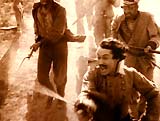 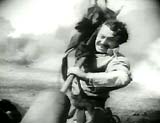 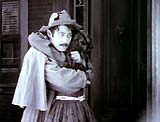 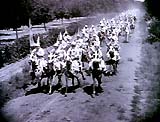
|
|
# 2. Way Down East (1920) The most stunning and realistic sequence ever filmed was completely real and extremely dangerous in its finale. This is the scene of Anna Moore's (Lillian Gish) daring, last-second rescue from a moving ice floe. The young woman is ejected from the rural Bartlett home during a raging blizzard when her secret past (an unmarried pregnancy) is revealed. Delirious from the cold and blinded by the snow, she falls down and faints on a slab of ice floe in the midst of an icy river. Lying on the ice block, her hand trails into the freezing water. As the ice thaws the next morning and breaks apart, her lifeless form is caught unconscious on moving ice-floes and is swept downstream toward a precipitous waterfall. The farmer's son David Bartlett (Richard Barthelmess) sees her floating toward the falls. Without a moment to lose, in an exciting, tense, "last minute rescue scene," he dashes out onto the wobbly icecakes and nimbly jumps from one moving, bobbing ice block to another to try to reach her before the ice jam gives way - rushing to the falls toward her death. As Anna regains consciousness, but starts to sink into the frigid water at the edge of the falls, David finally reaches her, scoops her up and saves her, running perilously upstream (and keeping his balance) on unstable blocks of ice to reach the shore. |
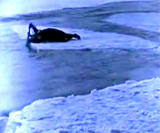 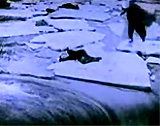 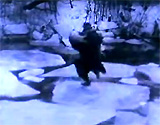 |
|
# 3. Safety Last (1923) This film earned Harold Lloyd, the bookish, horn-rimmed glasses-wearing comedian, his nickname "the King of Daredevil Comedy." The film is best remembered for its thrilling, hair-raising climax - a reckless, 'safety last,' humorous stunt on the side of a twelve-story skyscraper above busy city streets. The scary sequence was deliberately shot with most of the camera compositions including views of the perilous drop behind him. In the remarkable, daredevil sequences, the Boy inches his way up and climbs to the top of the twelve-story building, one hand and foot hold after the other, encountering absurdly new difficulties at every new floor - pesky, flapping pigeons who feast on nuts that have fallen on him from above, a volleyball net that becomes enveloped around him, painters who thrust a protruding 2 x 4 wooden paint platform/trestle at him, a swinging window, a clock, a rope (without a counterweight), a vicious dog, a flagpole, a mouse which climbs up his pants leg, a photographic subject who is posing with a gun pointed at him at the exact moment the flash explodes, a revolving anenometer, and a second rope entangled around his ankle which swings him pendulum-like from the top of the building. The most-remembered obstacle is the clock. For thrilling moments, he hangs from the minute-hand of the large clock, dangling dangerously above the street as the clock-face pulls off the wall - while still wearing his glasses (but he loses his straw hat) He finally reaches the top of the building, lands in the girl's arms on the roof, and they go off arm in arm. Our hero has proved his worth, become a success, earned the $1,000 prize money, and won the girl. Unbeknownst to the Boy, he tromps through fresh tar on the roof of the building, leaving - in four steps - his shoes and socks behind. |
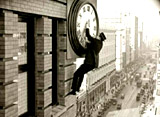 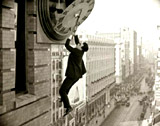 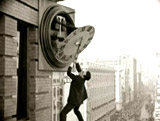
|
|
# 4. Greed (1924) The tragic ending in the great salt flats of Death Valley in Erich von Stroheim's masterpiece is absolutely remarkable. Marcus (Jean Hersholt) joins a posse and pursues his old friend/dentist McTeague (Gibson Gowland), greedy for the $100 reward offered following the suspicious murder and burglary of Trina McTeague (Zasu Pitts) - and for the wife's gold coins. "McTeague was headed for the very heart of Death Valley...that horrible wilderness of which even beasts were afraid." In the closing sequence, McTeague flees with Trina's money into the stifling heat and wasteland of Death Valley - a literal hell and a symbolic representation of the expansive, desolate terrain of McTeague's inner world. In a protracted fight to the death in the middle of the parched desert covered with caked ground and cracked alkaline, the two men face each other and grapple together for the gold as they wrestle for control of the gun. They struggle on the white ground, until McTeague overpowers Marcus and strikes with the revolver - he clubs his one-time friend to death with the gun. Marcus lies still and bloody on the ground - yet in the midst of the life and death struggle, McTeague's left wrist has become attached to Marcus' right wrist - by handcuffs. He turns and looks at the canvas bag (with gold coins) on the saddle of the dead mule, looks at the empty canteen, and sinks to his knees. He sits there, anchored in the deadly, pitiless heat of Death Valley, chained to the corpse of his once close friend that he just slew. He has the gold, but no water. There is only vast emptiness around him as he awaits his own death. |
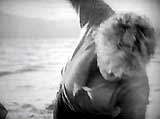   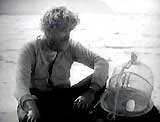
|
|
# 5. Battleship Potemkin (1925) The most famous sequence in Sergei Eisenstein's classic is the climactic massacre of local townspeople on the Odessa steps - in a film celebrating the 20th anniversary of the failed 1905 revolution in Russia against the czar. The scene is beautifully orchestrated with a montage of close-ups of faces and objects and long-shots, all rapidly cut together and contrasted as the images build to a devastating conclusion. Czarist troops, with drawn rifles to quell a revolutionary movement circa 1905, march down a flight of stone marble steps leading to the harbor where the people of Odessa are cheering the men on the czarist-armed battleship cruiser Potemkin at the port on the Black Sea. Successive waves of white-uniformed soldiers appear - ordered by city officials loyal to the czar to attack the riled-up citizenry. Shots ring out as they fire on the civilians, bringing about dizzying chaos as terrified people rush to flee down the steep stairs. One woman - whose son has been shot - cradles his bloodied body in her arms and approaches the army to defy them - she stands in their elongated shadows before she too is gunned down point-blank. A young mother is hit in the mid-section, and the force of her falling body causes her baby carriage to tumble out of control down the steps. In a startling close-up, the lens of a woman's glasses splinters and blood gushes from her eye socket. |
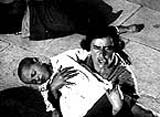 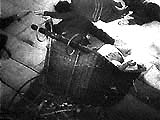 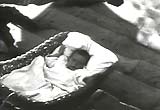 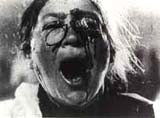
|
|
The scene of the parting of the American troops from a French village in King Vidor's war film is one of the most famous and memorable in cinematic history. American doughboy Jim (John Gilbert) calls out for French peasant girl Melisande (Renee Adoree) but cannot locate her. She too hears the bugle call and sees the dust of the trucks, the horse-drawn caissons, and the running men assembling for the pull-out. Her distress rises with the suddenness of their leaving. Suddenly, she decides that she is desperately in love with Jim. She pushes her way through the massed ranks of soldiers - looking and calling out for him in the ensuing chaos and rising dust. Her frenzied search becomes more frantic and emotional as she searches for a glimpse of him to bid him a lasting farewell. Two other passing soldiers grab at her - one touches her breast, the other tries to steal a kiss. Jim climbs into the back of a transport truck, one in a long line of battle trucks. When he finally catches sight of her, he jumps off the truck and races back - they wildly embrace and pepper each other with kisses - framed in close-up. Earnestly, he vows to return to her in the touching scene: "I'm coming back! - Remember - - - I'm coming back!" An officer pulls on Jim, and then rips them apart. The agonized, feisty French village girl hits back at anyone who would tear them from each other. As Jim is dragged into the tail end of a truck, Melisande holds on firmly to his left leg - refusing to let go. She runs along for a moment as the truck pulls away - she desperately hangs onto a chain dangling off the vehicle, trying to halt the inevitable and defy both time and fate. When she won't let go, she is dragged alongside the procession until she can't hold on any longer. He tosses her mementos to remember him by: his wristwatch, his dogtags, and one shoe, and then sprays her with two-handed kisses. She stands and watches the truck disappear - holding his shoe to her bosom. The passing vehicles and clouds of dust envelope her - and then subside. In the middle of the road, she sinks to her knees with her head bowed. [The realistic battle scenes in the film are also legendary, especially the harrowingly realistic battle scene of the soldiers' chilling march into enemy machine gun sniper fire at Belleau Wood.] |
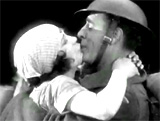 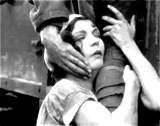 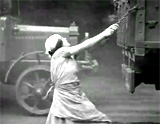 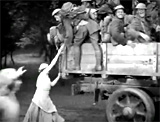 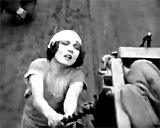 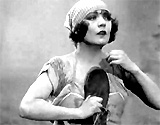
|
|
# 7. The Gold Rush (1925) A legendary scene is the one in which two famished fortune-seekers during the Alaskan Klondike gold rush celebrate Thanksgiving Day dinner. In their isolated cabin, the starving Lone Prospector (Charlie Chaplin) cooks his own boot in a large pot. He takes on airs as a French gourmet at a feast. When he serves the shoe, he splits the sole, cutting it like a filet, and sets the smaller portion before his large companion Big Jim McKay (Mack Swain). Big Jim greedily switches the plates to get the upper portion of the shoe. The Prospector delicately chews on the lower sole part, treating it like a delicacy as he picks his way through the leather - he treats the laces like spaghetti, coiling them about his fork. He daintily sucks the nails, like they were the bones of a game bird. [The famous dancing dinner-roll scene in the same film rates highly.] |
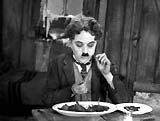 
|
1950s (1) | 1950s (2) | 1960s | 1970-90s |
|